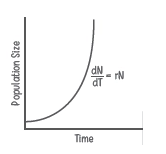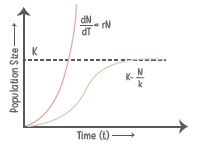Organisms and Populations Class 12 Notes Biology Chapter 13 - CBSE
Chapter:13
What are Organisms and Populations?
Ecology
Abiotic Factors
The branch of biology that deals with the relations of organisms with each other and with their physical surroundings are known as ecology.
Different factors that affect physical and chemical conditions of habitats
| Temperature | Water | Light | Soil |
|
|
Sun light is the major source of energy for photosynthesis. | pH, mineral composition, topography, water holding capacity affects the type of vegetation that grows in that area. |
|
|
||
| ➥ Eurythermal: Tolerate wide range of temperature | ➥ Euryhaline:Tolerate wide range of salinity. | ||
| ➥ Stenothermal: Tolerate only narrow range of temperature. | ➥ Stenohaline: Can only tolerate narrow range of salinity. |
Responses To Abiotic Factors
Homeostasis: The ability of an organism to maintain its internal environment constant even when external environmental conditions vary.
| Regulators | Conformers | Migratory | Suspend |
| Maintain constant body temperature (thermoregulation), and constant osmotic concentration (osmoregulation). Examples – mammals | Small animals have large surface area compared to volume and this helps in loosing less amount of heat which turns out to be less expensive process. Hence small size animals are found more in polar regions. | Animals migrate temporarily to avoid stressful conditions. | Mechanisms adopted by animals to deal with stressful situations. |
Biotic Factors
| Animals | Plants | Bacteria | Moss |
| It plays an essential roles in the formation and maintenance of the ecosystems they live in. For example, one ecological role of animals in their environment is to act as consumers, which is a vital part of the community dynamics and energy flows of the ecosystem. | These are also biotic factors in an environment. Their dependency, however, on other biotic factors, in terms of food is not as extensive as the animals that hunt and prey. They produce their own food by photosynthesis. | Bacteria are the most abundant and genetically diverse organisms on the planet, and their activity is vital for many aspects of biogeochemical cycling and ecosystem function. | It also play a vital role in the development of new ecosystems. They are among the first plant colonisers of disturbed sites, such as when an area is deforested or affected by forest fires. They stabilise the soil surface and retain water, helping new plants to grow. |
Responses To Biotic Factors
Biotic factors are living things within an ecosystem; such as plants, animals, and bacteria, while abiotic are non-living components; such as water, soil and atmosphere. The way these components interact is critical in an ecosystem. Biotic factors such as the presence of autotrophs or self-nourishing organisms such as plants, and the diversity of consumers also affect an entire ecosystem. Abiotic factors affect the ability of organisms to survive and reproduce. Abiotic limiting factors restrict the growth of populations.
Adaptation
Pollen grains/male gametophyte - spherical in shape and made up of 2 layers+ 1 Germ Pore+ 2 Cells
|
↓ |
Behavioural Response ↓ Desert lizards: Bask in sun to avoid coldness and move to shade when hot. Some burrow and hide into the soil to escape from the ground heat. |
|
Population
Group of individuals which share or compete for similar resources and interbreed among themselves.
Population Attributes
- Sex ratio: Male is to Female ratio in a population.
- Birth rate: Average no. of young ones born in a period of time.
- Death rate: Average no. of deaths in a period of time.
- Population density: Population density is the number of individuals per unit geographical area, for example, number per square meter, per hectare, or per square kilometer.
- Age pyramid: Plot of age distribution (%) of individuals of a given age or age group. It reflects whether growth is:




Density Changes By Change In Four Basic Processes
- Natality (N): Increase population (due to birth)
- Immigration (I): Increase population (individuals of same species which have come from some other place)
- Mortality (M): Decrease population (due to death)
- Emigration (E): Decrease population (individuals of a population who have gone elsewhere)
Population density will increase if (B+I) > (D+E)
Change in population size = (Births + Immigration) – (Deaths + Emigration)
Growth Models
Pattern of a population growth can be shown with the help of growth model.
Types of Growth Model
- ➥ Exponential
- ➥ Logistic
| Exponential Growth | Logistic Growth |
| When resources are unlimited, population grows exponentially. dN/dt – increase/decrease in N during time t Then, dN/dt = (b – d)*N Let (b – d) = r, then dN/dt = r*N | When a population has limited resources it showslag phase, phase of acceleration, asympotecarrying capacity = K |
 |
 |
Population Interactions
There are more than one kind of species which are available in a habitat and these species interact mutually.
| S.No. | Types of Interaction | Species 1 | Species 2 | General Nature of Interaction |
Examples |
| 1. | Amensalism | – | 0 | Biological interaction where one species causes harm to another organism without any cost or benefits to itself. |
Penicillum killing bacteria |
| 2. | Mutualism | + | + | Interaction favourable to both species and obligatory. | Between fungus & algae (Lichen) |
| 3. | Commensalism | + | 0 | HRelationship between two living organisms in which one organism benefits from the other without harming it. |
Sucker Fish on shark |
| 4. | Competition | – | – | Direct inhibition of each species by the other. | Birds compete with squirrels for units and seeds |
| 5. | Parasitism | + | – | Symbiotic relationship where the parasite (smaller in size), lives on or inside the host (larger in size), causing it some harm. |
Ascaris and tapeworm in human digestive tract |
| 6. | Predation | + | – | Biological interation where predator (larger in size), kills and eats another organism, its prey (smaller in size). |
Lion Predatory on deer |
Types of Growth Model
| Ecto-parasitism | Endo-parasitism | Brood Parasites |
| Ectoparasitism is a form of parasitism where the parasite lives outside the body of the host. E.g. Lice and ticks | Endoparasitism are parasites that live within the body of their host. E.g. hook worms | The brood parasite manipulates a host, either of the same or another species, to raise its young as if it were its own, using brood mimicry. E.g. Cuckoo, Mochokidae cat fish |
Share page on
Chapterwise Notes Class 12 Biology
- Sexual Reproduction In Flowering Plants
- Human Reproduction
- Reproductive Health
- Principles of Inheritance and Variation
- Molecular Basis of Inheritance
- Evolution
- Human Health and Diseases
- Microbes in Human Welfare
- Biotechnology Principles and Processes
- Biotechnology and its Applications
- Organisms and Populations
- Ecosystem
- Biodiversity and Conservation
CBSE CLASS 12 Notes
- CBSE Class 12 Physics Notes
- CBSE Class 12 Chemistry Notes
- CBSE Class 12 Biology Notes
- CBSE Class 12 Maths Notes
- CBSE Class 12 Accountancy Notes
- CBSE Class 12 Business Studies Notes
- CBSE Class 12 Economics Notes
- CBSE Class 12 History Notes
- CBSE Class 12 Geography Notes
- CBSE Class 12 Political Science Notes
CBSE CLASS 12 SYLLABUS
- CBSE Class 12 English core Syllabus
- CBSE Class 12 Mathematics Syllabus
- CBSE Class 12 Physics Syllabus
- CBSE Class 12 Chemistry Syllabus
- CBSE Class 12 Biology Syllabus
- CBSE Class 12 Accountancy Syllabus
- CBSE Class 12 Business Studies Syllabus
- CBSE Class 12 Economics Syllabus
- CBSE Class 12 History Syllabus
- CBSE Class 12 Geography Syllabus
- CBSE Class 12 Political science Syllabus
- CBSE Class 12 Sociology Syllabus
- CBSE Class 12 Psychology Syllabus
- CBSE Class 12 Physical education Syllabus
- CBSE Class 12 Applied mathematics Syllabus
- CBSE Class 12 History of Indian Arts Syllabus
